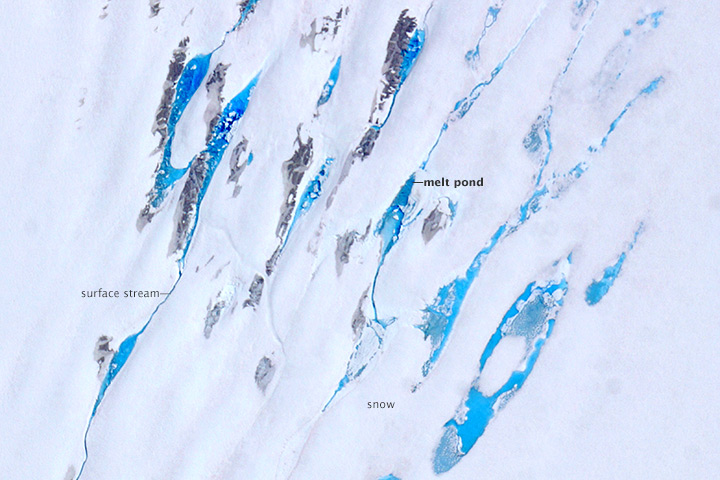We published a photograph of a lone turquoise melt pond as our Image of the Day on August 2, 2014. Although that was one of the largest that scientists participating in the 2014 MABEL campaign saw, it certainly wasn’t the only one. In fact, that melt pond had plenty of company—and we had no shortage of photos of them.
The digital camera that captured the lone melt pond was taking a picture every 3 seconds, with each frame showing an area about 2.5 by 1.5 kilometers (1.6 by 0.9 miles). There were thousands of photographs to choose from, and many of them were spectacular. Above are two favorites. The upper image shows several narrow melt ponds and surface streams on a glacier in southeastern Alaska; the lower photo shows even more melt ponds on thinning sea ice.
Though melt ponds make for nice aerial photographs, they’re also a topic of great interest to scientists. In 2012, American researchers published an interesting study that detailed how melt ponds produce fractal patterns that can be useful for understanding the dynamics of sea ice melting. (For a more readable write-up, try this Scientific American blog post.) In 2014, scientists from the United Kingdom argued that the amount of water in spring melt ponds could be used to make skillful predictions about how much ice will melt during the height of summer.






These melt ponds are extremely relevant in the rapid melting process of Greenland’s ice sheet. From a structural perspective, imagine the swiss cheese ice floating on a sea above bedrock. The very height of the ice column is a problem. Once a collapse begins the nearly melted ice will shatter into mush and collapse all the way down to as it falls creating what might be a huge ice flow discharge all the way to the ocean. This is what worries me about the so called 1 meter ocean rise in the IPCC forecast for the end of the century. Once this ice structure collapses the ocean rise will be very rapid. The only thing we don’t know is what decade it will occur in. However at this rate of ice structural damage it will surely collapse well before 2100 creating world wide havoc with rapid ocean rises. And the rise is permanent.